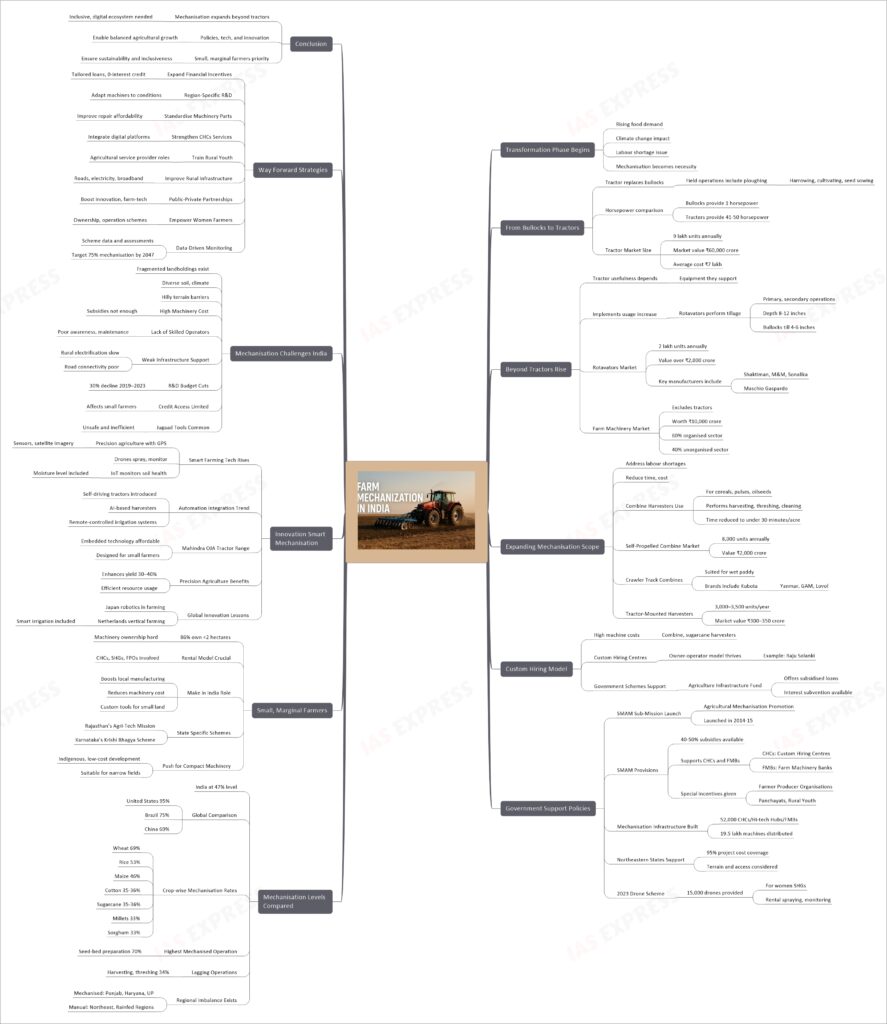Farm Mechanization in India: Challenges, Progress, and the Road Ahead

From Current Affairs Notes for UPSC » Editorials & In-depths » This topic
IAS EXPRESS Vs UPSC Prelims 2024: 85+ questions reflected
India’s agricultural sector has entered a pivotal transformation phase. In the backdrop of rising food demand, climate change, and labour shortages, farm mechanisation is no longer a luxury but a necessity. Recently, Parliament discussions and multiple industry reports have highlighted India’s gradual but determined shift beyond just tractors, towards smarter and more inclusive mechanisation across the farming value chain.

From Bullocks to Tractors: The First Leap
- Historically, tractors replaced bullocks to perform crucial field operations such as ploughing, harrowing, cultivating, and seed sowing.
- While a pair of bullocks offered just 1 horsepower, modern Indian tractors range between 41-50 horsepower, drastically increasing efficiency.
- Today, India’s tractor market stands at around 9 lakh units annually, valued at over ₹60,000 crore. A standard 45 hp tractor typically costs ₹7 lakh.
Going Beyond Tractors: Rise of Farm Machinery
- Tractors alone do not define farm mechanisation. Their efficiency lies in the equipment they pull or support.
- Implements like rotavators perform both primary and secondary tillage, digging deeper (8-12 inches) than bullock-drawn tools (4-6 inches), and preparing seedbeds more effectively.
- Rotavators have become a booming market with 2 lakh units sold annually, worth over ₹2,000 crore. Key manufacturers include Shaktiman, M&M, Sonalika, and Maschio Gaspardo.
- The broader farm machinery market in India (excluding tractors) is currently worth ₹10,000 crore, with a 60-40 split between organised and unorganised sectors.
Expanding Mechanisation: Harvesters, Transplanters, and More
- Mechanisation is expanding to address labour shortages and reduce operational time and cost.
- Combine harvesters are now used for cereals, pulses, and oilseeds, completing harvesting, threshing, and cleaning in under 30 minutes per acre compared to traditional two-day manual efforts.
- India’s annual market for self-propelled combines is around 8,000 units, worth ₹2,000 crore.
- For wet paddy fields, crawler track combines are preferred, with major players including Kubota, Yanmar, GAM, and Lovol.
- Smaller farmers use tractor-mounted harvesters, contributing to 3,000–3,500 units/year, worth ₹300–350 crore.
The Model of Custom Hiring: Accessibility over Ownership
- High costs of machines like combines and sugarcane harvesters restrict individual ownership.
- Custom hiring centres (CHCs) and owner-operator models offer a practical solution. Farmers like Raju Solanki from Madhya Pradesh use personal machines to service others’ fields, earning incomes while reducing costs for peers.
- Government-backed schemes like the Agriculture Infrastructure Fund help with subsidised loans and interest subvention, making mechanisation more viable for rural entrepreneurs.
Government Support and Policy Interventions
- The Sub-Mission on Agricultural Mechanisation (SMAM), launched in 2014-15, plays a key role in promoting mechanisation through financial assistance.
- Under SMAM:
- 40-50% subsidy is given to farmers for buying machinery.
- Custom Hiring Centres (CHCs) and Farm Machinery Banks (FMBs) are supported to offer rental services to smallholders.
- Special incentives are offered to farmer producer organisations (FPOs), panchayats, and rural youth.
- As of 2024, over 52,000 CHCs/Hi-tech Hubs/FMBs have been established, and more than 19.5 lakh machines distributed to farmers.
- North-Eastern states receive up to 95% project cost coverage, recognising their low mechanisation and tough terrain.
- In 2023, a new scheme was launched to provide 15,000 drones to women SHGs to deliver agri-services like spraying and monitoring on a rental basis.
Current Mechanisation Levels and Global Comparisons
- As of 2024, India’s overall farm mechanisation stands at 47%, far behind:
- United States (95%)
- Brazil (75%)
- China (60%)
- Crop-wise mechanisation in India:
- Wheat: 69%
- Rice: 53%
- Maize: 46%
- Cotton and Sugarcane: Around 35-36%
- Millets and Sorghum: 33%
- Highest mechanisation is seen in seed-bed preparation (70%), while harvesting and threshing lag at 34%.
- Mechanisation remains concentrated in Punjab, Haryana, and parts of Uttar Pradesh, whereas Northeast India and rainfed regions continue to depend heavily on manual labour.
Mechanisation for Small and Marginal Farmers
- Around 86% of Indian farmers own less than 2 hectares, making ownership of machinery difficult.
- For these farmers, rental models through CHCs, SHGs, and FPOs are crucial.
- The government, through Make in India, supports local manufacturing to reduce machinery costs and customise tools for small landholdings.
- State-specific programs, like Rajasthan’s agri-tech mission and Karnataka’s Krishi Bhagya scheme, offer additional subsidies and infrastructure support.
- There’s a growing push for indigenous, compact, and low-cost machinery for narrow fields and varied terrains.
Innovation and Smart Mechanisation
- Mechanisation in India is now moving beyond just machines to include smart farming technologies like:
- Precision agriculture using GPS, sensors, and satellite imagery.
- Drones for pesticide spraying and crop monitoring.
- IoT-based equipment to monitor soil health and moisture levels.
- Leading companies and startups are integrating automation in machines like self-driving tractors, AI-based harvesters, and remote-controlled irrigation systems.
- Mahindra & Mahindra’s new OJA tractor range showcases how technology is being embedded into affordable equipment tailored for small farmers.
- Precision agriculture not only enhances yield by 30–40% but also ensures efficient resource use, especially in water-scarce areas.
- Lessons from countries like Japan (robotics) and Netherlands (vertical farming and smart irrigation) are being adapted to Indian conditions.
Challenges Hindering Full-Scale Mechanisation
- Fragmented landholdings, hilly terrain, and diverse soil and climate conditions make uniform mechanisation difficult.
- High machine costs, even with subsidies, are still unaffordable for many small farmers.
- Lack of skilled operators and limited awareness prevent effective use and maintenance of machines.
- Slow rural electrification and poor road connectivity restrict access to powered equipment.
- Budget allocations for agriculture mechanisation R&D have seen a 30% decline between 2019-20 and 2022-23.
- Limited access to credit for small farmers reduces the ability to rent or purchase machines.
- Many small farmers continue to depend on jugaad (makeshift) tools, which are often unsafe and inefficient.
Way Forward
- Expand financial incentives specifically for small and marginal farmers, including tailored loan products and 0-interest credit.
- Invest in region-specific R&D for machinery suited to diverse Indian conditions.
- Promote standardisation of machinery parts to improve availability and reduce cost of repairs.
- Strengthen Custom Hiring Centres and integrate them with digital booking platforms to ensure real-time access to equipment.
- Train youth as agricultural service providers to operate, maintain, and lease machinery.
- Enhance rural infrastructure—roads, electricity, and broadband—to support machine mobility and digital services.
- Encourage public-private partnerships (PPPs) for innovation in farm tech and business models.
- Empower women farmers with targeted schemes for owning or operating machines, especially in states where their participation is high.
- Leverage data from schemes and impact assessments to identify gaps and monitor progress toward 75% mechanisation by 2047.
Conclusion
India’s farm mechanisation journey is at a crucial juncture. Moving beyond tractors to a broader ecosystem of advanced machinery and smart technologies can transform the sector. With targeted policies, inclusive models, and digital innovation, India can achieve a balanced and sustainable agricultural growth model that benefits all—especially small and marginal farmers.
Practice Question (250 words)
What are the key challenges faced by India in achieving 75% farm mechanisation by 2047, and how can region-specific strategies address them?
If you like this post, please share your feedback in the comments section below so that we will upload more posts like this.

